Tardy cme sparks auroras over Alaska:
Arriving hours later than expected, a CME brushed past Earth's magnetic field on Nov. 9th at approximately 0600 UT. At first the weak impact did little to spark geomagnetic activity. As Earth passed through the CME's magnetized wake, however, auroras did appear. Marketa Murray sends this picture from a spot outside Fairbanks, Alaska:"The CME arrived midnight Alaska time and we had amazing red auroras," says Murray.
In parts of Alaska, the light show lasted for hours. "A big campfire and a beautiful all-night aurora dance kept me warm and entertained in Alaska's chilly Interior near Nenana until 4:30 am," reports Todd Salat, who witnessed his own amazing display.
Bron: http://spaceweather.com/

Geomagnetische storm:
As predicted, Earth is entering a stream of solar wind, and this is causing minor G1-class geomagnetic storms on Nov. 11th. B.Art Braafhart sends this picture from Salla in the Finnish Lapland:
"Wow--a fabulous aurora outburst above Salla!" says Braafhart. "It was almost everywhere with purple colours and beautiful shapes."
More storms are in the offing as Earth moves deeper into the solar wind stream. Arctic sky watchers should be alert for auroras mixed with moonlight on Nov. 11th and 12th.
Bron: http://spaceweather.com/
De G1 klasse zonnestorm is gearriveerd en zorgt weer voor mooie plaatjes van aurora borealis
De zonnestorm is afkomstig uit onderstaand coronaal gat. De snelheid van de zonnewind is op dit moment 494,4 km/s met een dichtheid van 6,7 protonen/cm3.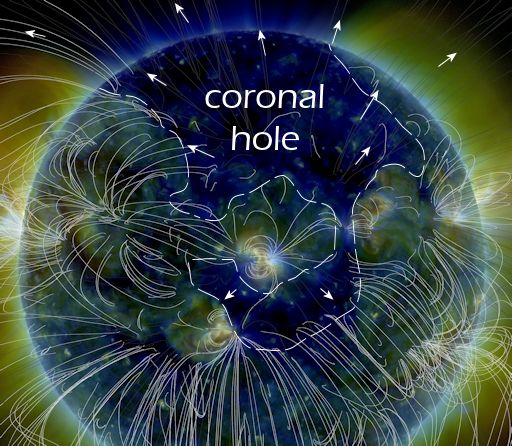
As predicted, today Earth is entering a stream of high-speed solar wind. First contact with the gaseous material sparked bright green auroras over Iceland. "We saw them through gaps in some nice lenticular clouds," reports Olivier Staiger, who sends this picture from the Fjallsarlon glacier lagoon:
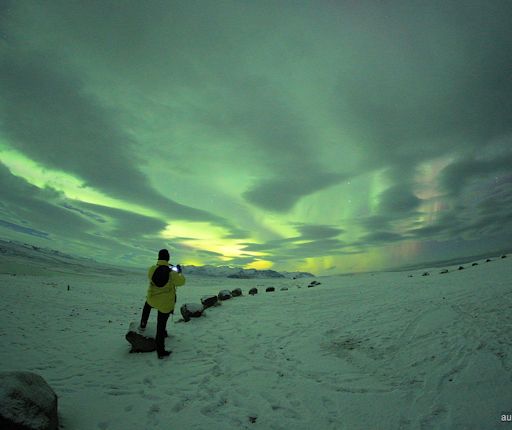
photo Olivier Staiger
"The auroras were nice and bright and wide--mostly green with a fringe of pink," says Saiger.
The solar wind stream responsible for this display may be here for a while. Flowing from a large hole in the sun's atmosphere, the stream is broad and should take several days to cross. Arctic auroras are possible from now until at least Nov. 25th.
Bron: http://spaceweather.com/ | Gewijzigd: 31 januari 2017, 15:45 uur, door Joyce.s
Aurora's 24 november (oorzaak: zie bovenstaand bericht):
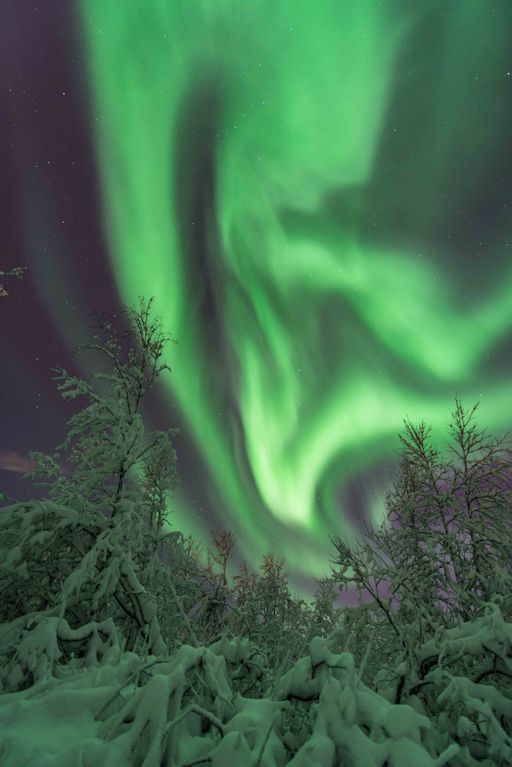
Taken by Mia Stålnacke on November 24, 2016 @ Kiruna, Sweden

Taken by Marianne Bergli on November 24, 2016 @ Troms

Taken by bruce chandler on November 24, 2016 @ Glen Alps, Chugach Mountains near Anchorage, Alaska

Taken by B.Art Braafhart on November 24, 2016 @ Salla, Finnish Lapland

Taken by Steve Kenny on November 24, 2016 @ Porjus Norrbotten Sweden

Taken by Todd Salat on November 24, 2016 @ Anchorage, Alaska
Bron: http://spaceweather.com/

Taken by Rob Powell on November 25, 2016 @ Near Stonehaven, Scotland

Taken by Gunnar Lysell on November 24, 2016 @ Nyköping, Sweden
http://spaceweather.com/ | Gewijzigd: 25 november 2016, 13:30 uur, door Joyce.s
De geomagnetische storm is nu ten einde, maar heeft nog meer prachtige foto's opgeleverd:

Taken by B.Art Braafhart on November 25, 2016 @ Salla, Finnish Lapland

Taken by GeorgeMiller on November 24, 2016 @ Troms Region

Taken by George Miller on November 24, 2016 @ troms Region

Taken by Sarah Skinner on November 26, 2016 @ Abisko

Taken by Yuichi Takasaka on November 25, 2016 @ Denali Park, Alaska, USA

Taken by B.Art Braafhart on November 28, 2016 @ Salla, Finnish Lapland

Taken by Doc Searls on November 27, 2016 @ Flying across Hudsons Bay, Canada
Bron: http://spaceweather.com/
Het heeft even geduurd, maar we hebben een M klasse zonnevlam geregistreerd
Yesterday, Nov. 29th, new sunspot AR2615 erupted, producing an impulsive M1-class solar flare. NASA's Solar Dynamics Observatory caught the flash of extreme ultraviolet (UV) radiation:
Following months of negligible solar flare activity, the sudden emergence of AR2615 and its subsequent explosion caught forecasters off guard. A pulse of UV and X-radiation from the explosion ionized the upper layers of Earth's atmosphere over the Pacific Ocean: map.
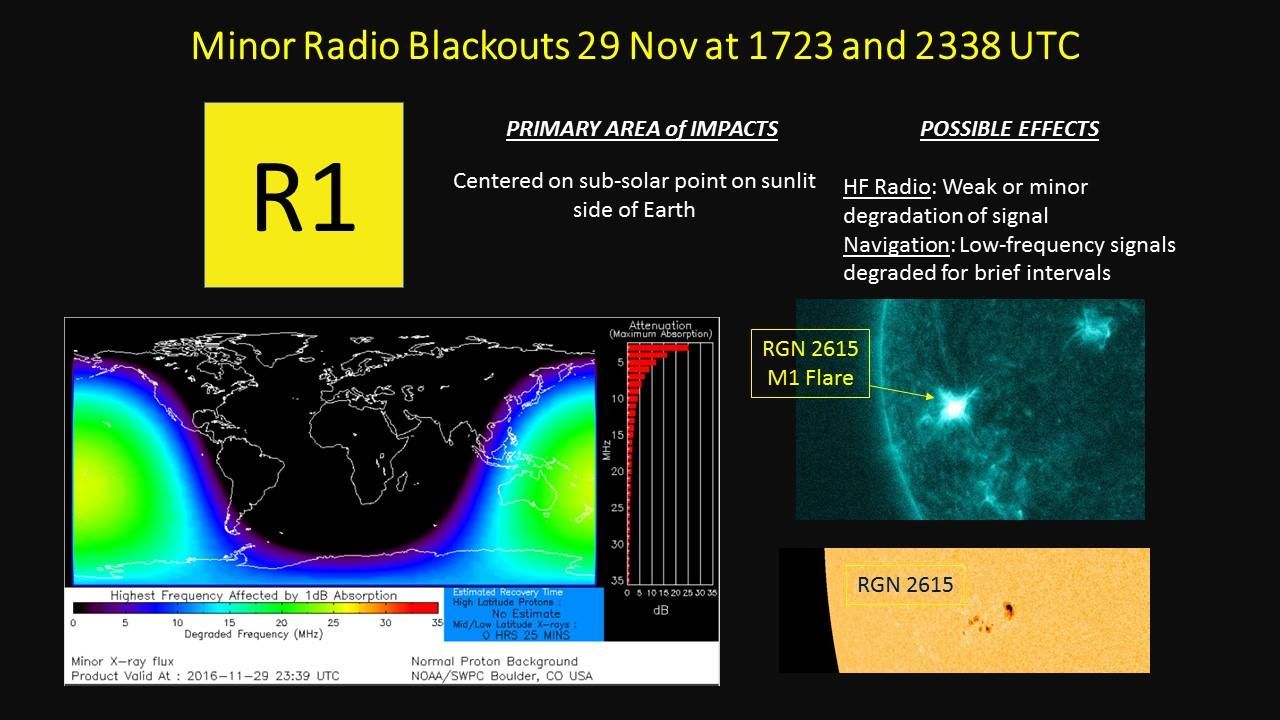
This affected the normal propagation of radio waves. Mariners and ham radio operators may have noticed brief fade-outs and/or unexpected hops at frequencies below ~10 MHz.
This was a relatively minor event, notable mainly because of the quiet that preceded it. NOAA forecasters estimate a 10% chance of additional M-flares on Nov. 30th.
Bron: http://spaceweather.com/
Hieronder: de M klasse zonnevlam


Bron: solarham.net
Hieronder: de magnetogram. Hoe meer interactie er is tussen de rode en blauwe gebieden, hoe groter de zonnevlammen worden.

Geomagnetische storm is onderweg

De zonnestorm, afkomstig van bovenstaand coronaal gat, zal de komende dagen arriveren en een G1 klasse zonnestorm geven (KP5).
GEOMAGNETIC STORM WATCH:
Minor G1-class geomagnetic storms are likely for the next three days as Earth passes through a high-speed stream of solar wind. The action is expected to commence on Dec. 7-8 with the arrival of a CIR (co-rotating interaction region). CIRs are transition zones between slow- and fast-moving solar wind. Solar wind plasma piles up in these regions, producing density gradients and shock waves that do a good job of sparking Arctic auroras. Solar wind blowing furiously behind the CIR could energize the light show through Dec. 10th.
GRAB A WINDOW SEAT: Are you flying at high latitudes this week? Travel tip: Grab a window seat. Ian Griffin heeded this advice on Dec. 6th and was rewarded with the following view:
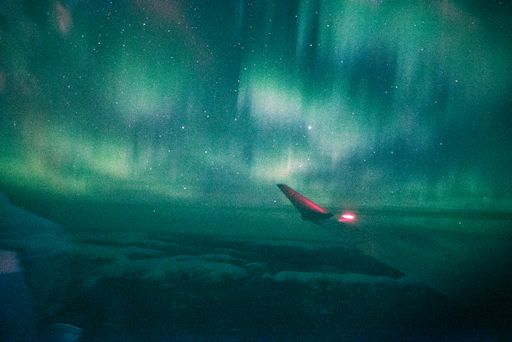
photo Ian Griffin
"I was on board Air Canada flight 8892 to Vancouver," says Griffin. "Once we cleared the clouds, I couldn't take my eyes or my camera away from the window. The auroral display 38,000 feet over Whitehorse at 6 a.m. was absolutely sublime."
The view should improve in the nights ahead as Earth enters a stream of high-speed solar wind, sparking even brighter auroras around the Arctic Circle on Dec. 7th through 10th. Stay tuned
Bron: http://spaceweather.com/
| Gewijzigd: 31 januari 2017, 15:46 uur, door Joyce.s
De geomagnetische storm is gearriveerd
Met een snelheid - op dit moment - van 612,7 km/s en een dichtheid van 5,3 protonen/centimeter3 zit de aarde nu middenin de zonnestorm, met als gevolg mooie aurora borealis.
Earth is now fully inside a stream of solar wind flowing from a large coronal hole on the sun. The buffeting action of the stream is causing intermittent auroras around the Arctic Circle--some of them quite bright. "We had a fantastic display in northern Sweden," reports Oliver Wright, who sends this picture from Abisko National Park:

photo Oliver Wright
"This was an aurora storm within a storm," says Wright, who spent the evening guiding a group of sky watchers for Lights over Lapland. "We went out in 100% clouds, strong winds and blowing snow. Suddenly, the clouds parted and the guests got to see a full-on aurora storm."
The stream of solar wind powering these auroras is broad, and it could take Earth two or three days to cross it. Arctic observers should be alert for more lights on Dec.9th and 10th.
Bron: http://spaceweather.com/

Taken by Sarah Skinner on December 8, 2016 @ Abisko, Sweden

Taken by Bernard Marschner on December 8, 2016 @ Fairbanks, Alaska, USA
Bron: http://spaceweather.com/ | Gewijzigd: 31 januari 2017, 15:47 uur, door Joyce.s
Wellicht geen witte, maar wel een "gekleurde" kerst
Vanaf 21 t/m 25 december komen we terecht in een Zonnestorm G1 klasse, dus tijd voor aurora's. De storm is afkomstig van een enorm coronaal gat, die bijna 1/3 van de zon omvat.Earth is about to enter a stream of fast-moving solar wind. G1-class geomagnetic storms are expected to begin on Dec. 21st with magnetic unrest continuing through Dec. 25th. Sky watchers around the Arctic Circle should be alert for Northern Lights.
The source of the solar wind is a gigantic hole in the sun's atmosphere, now directly facing Earth. NASA's Solar Dynamics Observatory photographed the structure, which covers nearly 1/3rd of the solar disk:
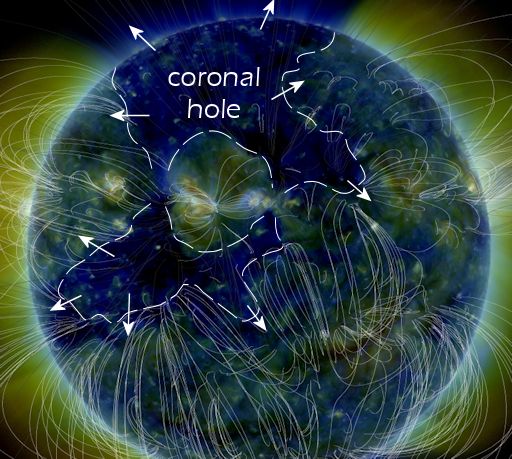

This is a "coronal hole"--a region in the sun's atmosphere where the magnetic field opens up and allows solar wind to escape. We've actually seen this coronal hole before--at least twice. It is rotating around with the sun, strobing Earth like a lighthouse every ~27 days. The last two times we experienced its solar wind (Oct. 25-28 and Nov. 23-26), G1- and G2-class magnetic storms sparked bright polar auroras. A repeat performance is likely in the week ahead.
AURORAS, NO SUNSPOTS REQUIRED:
All weekend long, the sun was blank--no sunspots. Fortunately, sunspots are not required for the aurora borealis. On Saturday night the sunspot number was zero when Sarah Skinner of Abisko, Sweden, witnessed a spray of green lights "bursting out from the top of Mount Nuolja and spreading across the sky with bursts of speeds and energy." She took this picture from the shore of Lake Torneträsk:
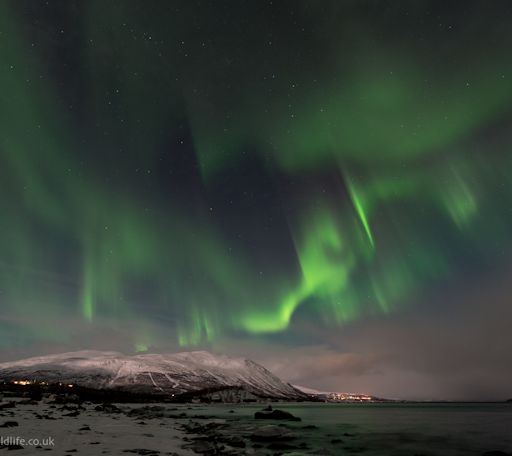
photo Sarah Skinner
"I was with a group of guests from Lights over Lapland when the clouds started to clear revealing the powerful aurora," she adds. "We all cheered with excitement!"
This display, and others like it happening nightly around the Arctic Circle, defy a popular misconception about the solar cycle. Many people believe that auroras vanish during periods of low sunspot number. In fact, polar auroras may be seen throughout the 11-year sunspot cycle. The energetic green lights Sarah Skinner photographed over Abisko were not ignited by a sunspot; instead, the job was done by a stream of solar wind buffeting Earth's magnetic field. Such streams occur throughout the solar cycle.
The sunspot number will likely hover near zero for the rest of the week. Nevertheless, the forecast calls for bright Arctic auroras as another significant stream of solar wind approaches Earth. Estimated time of arrival: Dec. 20-21. Stay tuned for sightings.
Bron: http://spaceweather.com/ | Gewijzigd: 31 januari 2017, 15:47 uur, door Joyce.s
Et Voila, daar is hij dan
De korste dag van het jaar, ziet er kleurrijk uit.As predicted, Earth is entering a stream of high speed solar wind on Dec. 21st. First contact produced a surge of ground currents in Lofoton, Norway--"a good sign for very nice Northern Lights," says Rob Stammes who measured the disturbance. Indeed, bright auroras are now dancing around parts of the Arctic Circle. Marketa S. Murray photographed these over Fairbanks, Alaska:
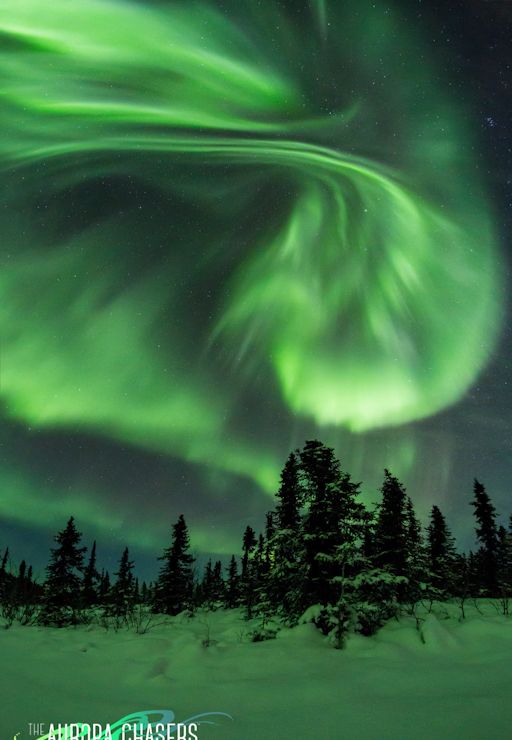
It's a winter wonderland up here," says Murray. "We got 8 inches of fresh snow, clear skies, and the auroras are amazing."
This is just the beginning. The solar wind stream is broad and Earth is expected to remain inside it for days. NOAA forecasters estimate a 60% chance of G1-class geomagnetic storms on Dec. 21-22. These are the longest nights of the year in the northern hemisphere; Arctic sky watchers will have plenty of darkness for aurora sightings.
Bron: http://spaceweathergallery.com/aurora_gallery.html
De lichtshow gaat door
Zoals al eerder gezegd bevinden we ons in een zonnestorm, afkomstig van een coronaal gat. (zie hieronder).De snelheid van de zonnewind is momenteel 725 km/s, met een dichtheid van 4 protonen/centimer 3

Taken by Helge Andersen on December 22, 2016 @ Orkanger City Norway Våvatnet

Taken by B.Art Braafhart on December 22, 2016 @ Salla, Finnish Lapland

Taken by B.Art Braafhart on December 22, 2016 @ Salla, Finnish Lapland

Taken by Rebecca Brogan on December 22, 2016 @ Hobart, Tasmania, Australia
Bron: http://spaceweathergallery.com/aurora_gallery.html
Kerstaurora's
Auroras are usually green. Occasionally, other colors appear: red, purple, blue. One color that never shows itself, however, is white--that is, not until last night. "I saw white auroras over Tromsø, Norway!" reports veteran observer Markus Varik. He recorded the phenomenon in this photo: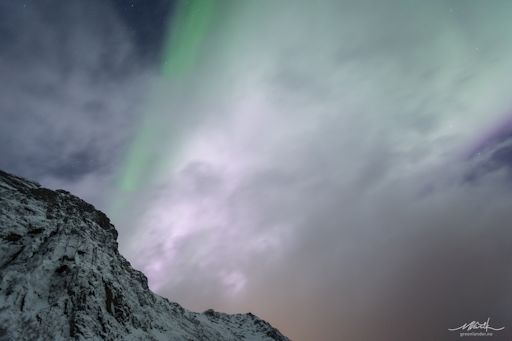
I've been working more than 400 nights as a Northern Lights guide, and although sometimes I think I've seen it all, never I have witnessed white auroras like that," says Varik. "It was amazing to see it unravel white like that in front of my eyes. Pure magic!"
Auroras get their colors from specific elements in Earth's upper atmosphere. Green auroras, for instance, come from atomic oxygen; blue is associated with molecular nitrogen. No element produces white. So where did it come from?
An important clue: Elsewhere in Scandinavia, intense ribbons of pale pink appeared. Here is a specimen recorded by an automated auroracam in Abisko, Sweden:
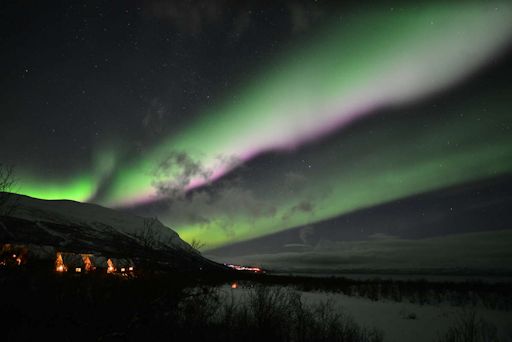
Sarah Skinner, a tour guide with Lights over Lapland, saw the display: "OMG, it was the pinkest aurora ever!"
The 'white auroras' Varik photographed might actually be pink auroras filtered and paled by low-hanging clouds. Indeed, there is a strong hint of pink in Varik's photo.
Pink auroras are somewhat rare, but hardly unprecedented. They appear when energetic particles from space descend lower than usual, striking nitrogen molecules at the 100 km level and below.
auroracam lapland: http://lightsoverlapland.com/webcams/
Bron: http://spaceweather.com/
G1 klasse zonnestorm, intensivering kosmische straling, desondanks op weg naar een zonneminimum
Morgen nadert een G1 klasse zonnestorm de aarde, afkomstig van het coronale gat dat nu aardegericht is. De zonnewindsnelheid zal rond de 650 km/s gaan bedragen.
http://spaceweather.com/images2017/16jan17/ch_strip.jpg
Op de zuidpool heeft men (University of Delaware's Bartol Research Institute) geconstateerd dat de kosmische straling aan het intensiveren is. Deze straling is niet afkomstig van de zon, maar vanuit de ruimte.
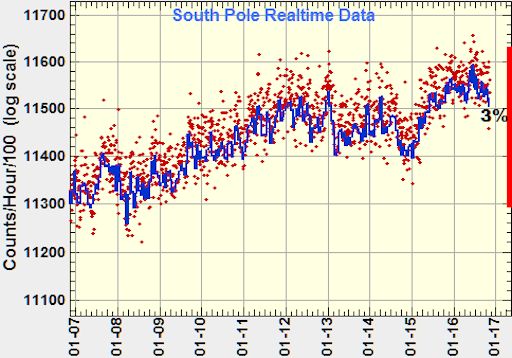
Dit is het teken dat het magnetisch veld van de zon aan het verzwakken is en we op een zonneminimum afstevenen.
Aangezien de kosmische straling (en geladen deeltjes) zich met een enorme snelheid door de ruimte verplaatsen (en in aanraking komt met ons magnetisch veld), zien we hier op aarde daardoor ook noorder- of zuiderlicht.
Bron: http://spaceweather.com/
Coronaal gat aardegericht en plasma filament
Op dit moment hebben we een aardegericht coronaal gat, die ons over circa 3 dagen (27e) weer noorder- en zuiderlicht zal gaan bezorgen.De zonnewind heeft op dit moment een snelheid van 446,3 km/s, dit zal dan nog gaan oplopen.
Daarnaast is er op dit moment een enorm plasma filament te zien, met een lengte van zo'n 80.000 km.
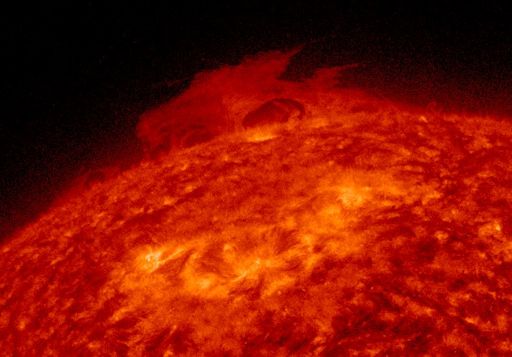
Mocht deze "los raken" dan zal hij niet aardegericht zijn.
Tevens heeft de zon enkele zonnevlekken. Echter, als het al tot een uitbarsting komt, verwacht ik niet dat het meer zal zijn dan een C-klasse (lichte uitbarsting).

Bronnen:
http://spaceweather.com/
http://solarham.net/latest_imagery/mag1.htm
Weekend aurora's
Earth is beginning to exit a stream of solar wind flowing from a large hole in the sun's atmosphere. As a result, NOAA forecasters have lowered the odds of a geomagnetic storm today to only 35%. Arctic sky watchers should nevertheless remain alert for midnight auroras on Feb 3-4 as the solar wind speed is still near 600 km/s. Free: Aurora alerts.When the solar wind stream first arrived on Jan. 31-Feb. 1, it delivered a blow to Earth's magnetic field that sparked locally intense lights around the poles. M-P Markkanen observed this outburst over Lemmenjoki National Park in the Lapland of Finland:
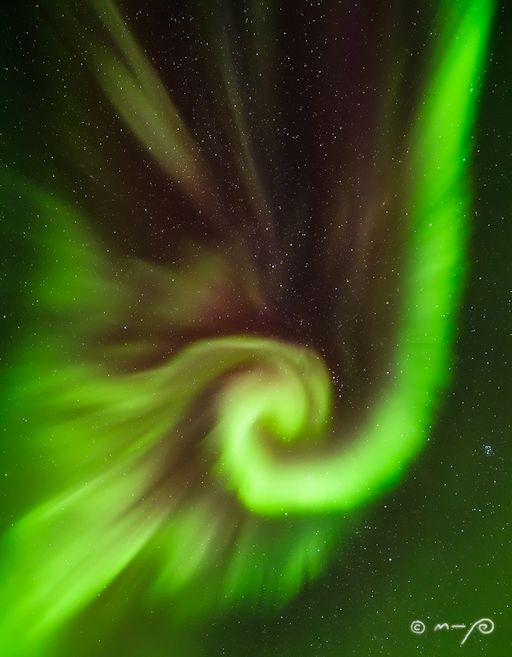
photo M-P Markkanen
"It was a mind blowing spectacle!" says Markkanen. "All night long, the sky was a showcase of aurora forms and colors -- green, red, pink, purple, white, arcs, curtains, coronas, pulsing, and at times the whole sky was just glowing green from north to south."
Bron: http://spaceweather.com/
G2 geomagnetische storm, zorgt voor "groene bergen" in Noorwegen
During an outburst of Northern Lights, most people stare at the sky. Sometimes, however, it pays to look at the ground. "On Feb. 18th, the mountains around us turned green," reports Didier Van Hellemojt from Tromsø, Norway, more than 200 miles north of the Arctic Circle. "The snowy slopes reflected the color of the green auroras overhead.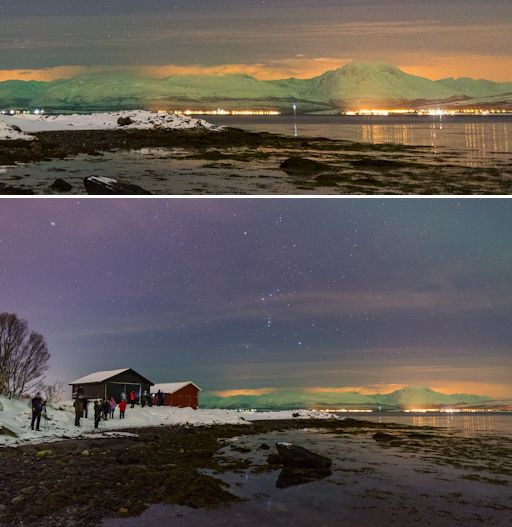
©Didier Van Hellemojt
Green terrain could become a common sight in the nights ahead. Earth is inside a wide stream of solar wind that will influence our planet, off and on, for the rest of the month. Activity could reach a crescendo at the end of February when, according to NOAA analysts, G2-class geomagnetic storms could erupt around the Arctic Circle.
Bron: http://spaceweather.com/
Filament eruptie en iets grotere kans op zonnevlammen
Yesterday, an explosion on the sun's eastern limb hurled a twisted plume of debris more than 250,000 km above the solar surface. NASA's orbiting Solar Dynamics Observatory recorded the blast: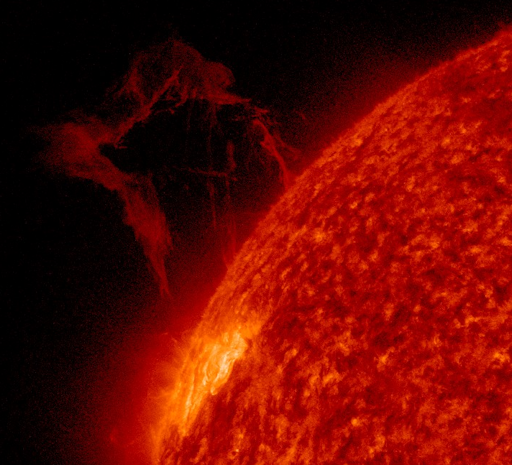
An 8-hr movie recorded by extreme ultraviolet telescopes onboard the spacecraft shows what happened: A tornado of magnetized plasma became unstable when the twister twisted a bit too much. Magnetic fields crissed, crossed, and exploded in a process known as "magnetic re-connection." The flying debris will not hit our planet; the blast was too far off the sun-Earth line.
Bron: http://spaceweather.com/
Solar activity continues at very low levels, although there is now an increased chance for minor C-Flares and a small chance for an isolated moderate M-Flare. This thanks to the addition of newly numbered region 2638, now in view off the northeast limb. More updates to follow regarding this active region whenever necessary.Also of interest today, a prominence eruption just behind the northeast limb. The towering stream of plasma was observed by the Solar Dynamics Observatory (SDO) beginning at 16:30 UTC (Feb 20). Because the event was not facing Earth, it should have no impact on our planet.
Stay tuned to SolarHam.com for the most up to date spaceweather news, data and imagery.

Bron: http://solarham.net/
Pollen Corona en aurora borealis
In parts of New Mexico, people are starting to sneeze--and see colorful rings around the sun. The two experiences are related. They are both manifestations of pollen. Photographer Harald Edens of Magdalena NM explains: "Every year in late February or early March, the juniper trees in New Mexico produce pollen. The pollen particles are all quite small and uniform in size; as a result, they scatter sunlight and produce colored rings around the sun."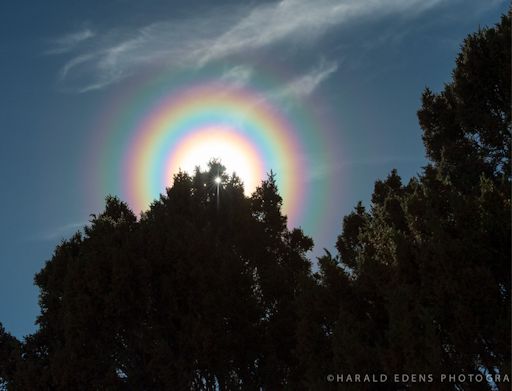
"Today's pollen corona was by far the most intense I have observed in New Mexico over the past 14 years, with up to four orders (repeated color bands) readily visible to the unaided eye," Edens continues. "The pollen is so abundant that it appears like smoke coming off the juniper trees whenever there is a gust of wind, or a bird lands in a tree."
Readers, if you see a pollen corona, here's something else to look for: The colorful rings are not always circular. Pollens are non-spherical; many have air sacs to help carry them in the wind. These align the grains to give beautiful elliptical coronas with bright spots.
Bron: http://spaceweather.com/
Aurora's:
Earth is moving deeper into a solar wind stream flowing from a hole in the sun's atmosphere. With wind speeds topping 600 km/s, the stream is buffeting our planet's magnetic field and sparking bright auroras round the Arctic Circle. Frank Olsen sends this picture from Morfjord at Lofoten, Norway:
©Frank Olsen
Click here to see Olsen's complete panorama. "We expected a G1 show last night," he says. "It didn't quite reach that strength, but I was still quite satisfied with what we got."
NOAA forecasters say there is a 50-50 chance that G1-class magnetic storms willoccur on Feb. 24th. That means the next photos could be even better.
Bron: http://spaceweather.com/
On Feb. 22nd, shortly after midnight, bright green auroras erupted over Alaska's Poker Flat Research Range. Researchers from Dartmouth College promptly launched a rocket into the glowing maelstrom. Photographer Marketa Murray of Fairbanks captured the event in a perfectly-timed self-portrait:
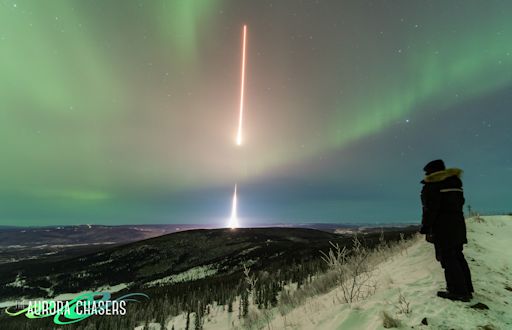
"We tuned into the Poker Flat Research Range radio for a heads-up that the rocket was about to launch," explains Murray. "The picture shows both stages of the Black Brant IX sounding rocket burning for the ionosphere."
The goal of the mission, named ISINGLASS (Ionospheric Structuring: In Situ and Groundbased Low Altitude Studies) is to decipher the mysterious shapes of the aurora borealis. Some auroras look like flames, others like swirls, ripples or curtains. The rocket was designed to scatter an array of sensors into the auroral zone, mapping the particles and fields underlying these forms.
"Auroras are the last step of a chain of processes connecting the solar wind to the atmosphere," says Dr. Kristina Lynch of Dartmouth, the mission's principal investigator. "We are seeking to understand what structure in these visible signatures can tell us about the electrodynamics of processes higher up."
"It was a beautiful launch with an extensive set of collaborative ground based data, and will make a great study," she says.
Ultimately, the results could allow researchers to look up at the sky and, based on little more than the shapes they see, predict conditions at the edge of space. Was the mission a success?
Bron: http://spaceweather.com/
G2 klasse zonnestorm zorgt weer voor mooie aurora's
Met een snelheid van 707,3 km/s wordt de aarde geraakt door een zonnewind die weer mooie foto's oplevert:Solar wind speeds are topping 700 km/s on March 3rd as Earth continues its 3-day journey through a stream of gaseous material flowing from a hole in the sun's atmosphere. This is sparking geomagnetic storms and beautiful auroras around the Arctic Circle. Rayann Elzein took this picture last night from Inari, Finland:
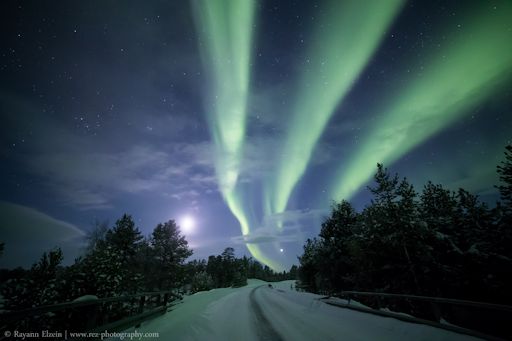
"The solar wind continues!" says Elzein. "Auroras were visible on the evening of March 2nd as soon as the sky became dark. Very strong auroras filled the sky. I quickly lost count of all the bright bands and fast coronas that appeared above us."
The display Elzein witnessed took place during a relatively minor G1-class magnetic storm. One night earlier, March 1st, an even stronger G2-class storm occurred, "and the auroras were epic," reports M-P Markkanen, who photographed the lights spilling over a 1356m high mountain called Otertinden in Storfjord, Norway:
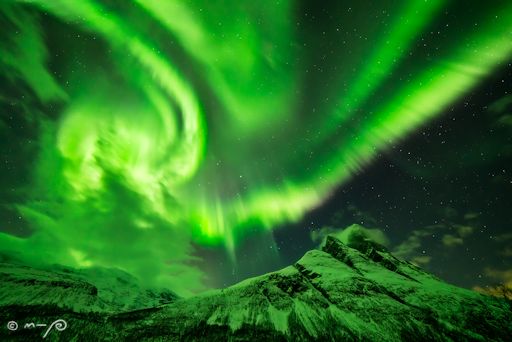
"I spent most of the night admiring this dramatic mountain under the storming auroras, which danced on and off all night long with several crazy coronas!" says Markkanen.
Arctic sky watchers should be alert for more auroras tonight. NOAA forecasters estimate a 40% chance of polar geomagnetic storms on March 3rd as the solar wind continues to blow.
Bron: http://spaceweather.com/
Pink aurora's:
Yesterday, the solar wind was supposed to slacken, prompting auroras around the Arctic Circle to fade. Instead, the wind quickened and there was an explosion of pink. "The display on March 5th was so intense, even the fjords changed color," reports Markus Varik, who sends this picture from Tromsø, Norway: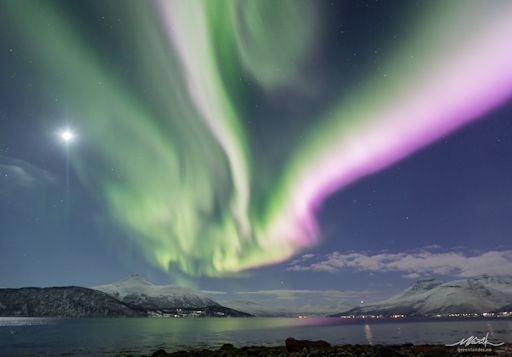
©Markus Varik
The auroras were amazingly colorful, and I was able to catch their reflections in the nearly still waters of the fjord," Varik explains.
Flamboyant displays of pink were also seen in Finland and Sweden, and caused some observers to cry out in amazement--"Wow, it's pink!"
The pink color is probably a sign of nitrogen. Most auroras are green--a verdant glow caused by energetic particles from space hitting oxygen atoms 100 km to 300 km above Earth's surface. Pink appears when the energetic particles descend lower than usual, striking nitrogen molecules at the 100 km level and below. Such deep-penetrating particles are being produced by the solar wind stream now blowing around Earth.
Arctic sky watchers should remain alert for pink (and other colors) as the solar wind continues to blow faster than 600 km/s on March 6th.
Bron:
http://spaceweather.com/

 Uitbarstingen van de zon en aurora borealis
Uitbarstingen van de zon en aurora borealis




